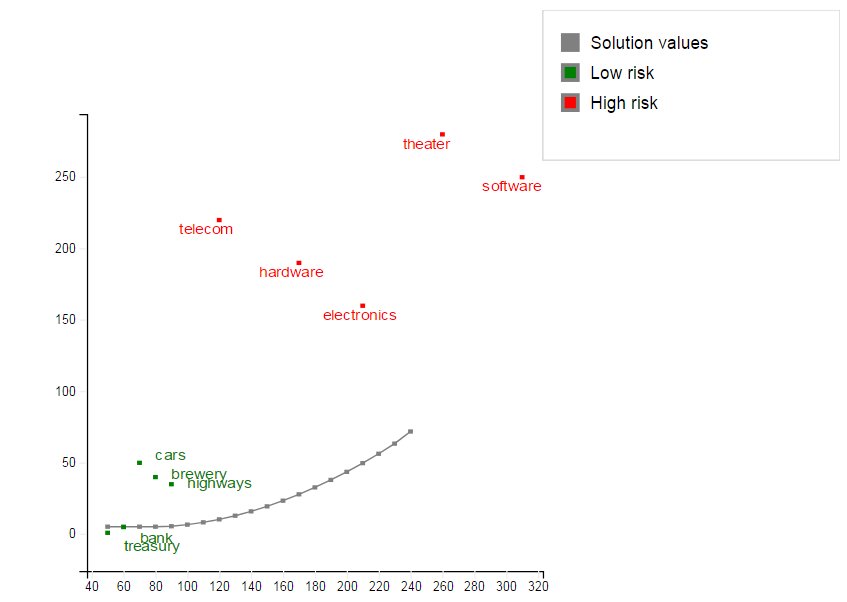QP
To adapt the model developed in Chapter 2 to the new way of looking at the problem, we need to make the following changes:
- New objective function: mean variance instead of total return.
- The risk-related constraint disappears.
- Addition of a new constraint: target yield.
The new objective function is the mean variance of the portfolio, namely:
where VARst is the variance/covariance matrix of all shares. This is a quadratic objective function (an objective function becomes quadratic either when a variable is squared, e.g., frac12, or when two variables are multiplied together, e.g., frac1 · frac2).
The target yield constraint can be written as follows:
The limit on the North-American shares as well as the requirement to spend all the money, and the upper bounds on the fraction invested into every share are retained. We therefore obtain the following complete mathematical model formulation:
∑s ∈ NA fracs ≥ MINAM
∑s ∈ SHARES fracs = 1
∑s ∈ SHARES RETs·fracs ≥ TARGET
∀ s ∈ SHARES: 0 ≤ fracs ≤ MAXVAL
Implementation with Mosel
In addition to the Xpress Optimizer module mmxprs we now also need to load the module mmnl that adds to the Mosel language the facilities required for the definition of quadratic expressions (mmnl is documented in the `Mosel Language Reference Manual'). We can then use the optimization function maximize (or alternatively minimize) for quadratic objective functions to start the solution process.
This model uses a different data file (folioqp.dat) than the previous models:
! trs haw thr tel brw hgw car bnk sof elc
RET: [ (1) 5 17 26 12 8 9 7 6 31 21]
VAR: [ (1 1) 0.1 0 0 0 0 0 0 0 0 0 ! treasury
(2 1) 0 19 -2 4 1 1 1 0.5 10 5 ! hardware
(3 1) 0 -2 28 1 2 1 1 0 -2 -1 ! theater
(4 1) 0 4 1 22 0 1 2 0 3 4 ! telecom
(5 1) 0 1 2 0 4 -1.5 -2 -1 1 1 ! brewery
(6 1) 0 1 1 1 -1.5 3.5 2 0.5 1 1.5 ! highways
(7 1) 0 1 1 2 -2 2 5 0.5 1 2.5 ! cars
(8 1) 0 0.5 0 0 -1 0.5 0.5 1 0.5 0.5 ! bank
(9 1) 0 10 -2 3 1 1 1 0.5 25 8 ! software
(10 1) 0 5 -1 4 1 1.5 2.5 0.5 8 16 ! electronics
]
RISK: [2 3 4 9 10]
NA: [1 2 3 4] Note that we have chosen to use numerical instead of string indices. Since the set SHARES is defined in the model, we do not have to list the index-tuple for every data entry in the file—those tuples given are for clarity's sake only.
model "Portfolio optimization with QP/MIQP"
uses "mmxprs", "mmnl" ! Use Xpress Optimizer with QP solver
parameters
MAXVAL = 0.3 ! Max. investment per share
MINAM = 0.5 ! Min. investment into N.-American values
MAXNUM = 4 ! Max. number of different assets
TARGET = 9.0 ! Minimum target yield
end-parameters
declarations
SHARES = 1..10 ! Set of shares
RISK: set of integer ! Set of high-risk values among shares
NA: set of integer ! Set of shares issued in N.-America
RET: array(SHARES) of real ! Estimated return in investment
VAR: array(SHARES,SHARES) of real ! Variance/covariance matrix of
! estimated returns
end-declarations
initializations from "folioqp.dat"
RISK RET NA VAR
end-initializations
declarations
frac: array(SHARES) of mpvar ! Fraction of capital used per share
end-declarations
! Objective: mean variance
Variance:= sum(s,t in SHARES) VAR(s,t)*frac(s)*frac(t)
! Minimum amount of North-American values
sum(s in NA) frac(s) >= MINAM
! Spend all the capital
sum(s in SHARES) frac(s) = 1
! Target yield
sum(s in SHARES) RET(s)*frac(s) >= TARGET
! Upper bounds on the investment per share
forall(s in SHARES) frac(s) <= MAXVAL
! Solve the problem
minimize(Variance)
! Solution printing
writeln("With a target of ", TARGET, " minimum variance is ", getobjval)
forall(s in SHARES) writeln(s, ": ", getsol(frac(s))*100, "%")
end-model This model (file folioqp.mos) produces the following solution output (tab Output/input of the solution information window):
With a target of 9 minimum variance is 0.5573934236 1: 29.99999999% 2: 7.153923216% 3: 7.382487455% 4: 5.463589348% 5: 12.6553572% 6: 5.911771509% 7: 0.3330412872% 8: 29.99996789% 9: 1.099855797% 10: 6.303833229e-06%
Similarly to the algorithm shown in Chapter 5, we may re-solve this problem with different values of TARGET and plot the results in a target return/standard deviation graph, know as the `efficient frontier' (model file folioqp_graph.mos):

Figure 8.1: Graph of the efficient frontier
© 2001-2025 Fair Isaac Corporation. All rights reserved. This documentation is the property of Fair Isaac Corporation (“FICO”). Receipt or possession of this documentation does not convey rights to disclose, reproduce, make derivative works, use, or allow others to use it except solely for internal evaluation purposes to determine whether to purchase a license to the software described in this documentation, or as otherwise set forth in a written software license agreement between you and FICO (or a FICO affiliate). Use of this documentation and the software described in it must conform strictly to the foregoing permitted uses, and no other use is permitted.

